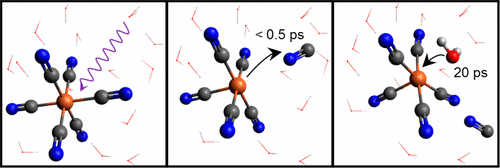当前位置:
X-MOL 学术
›
J. Am. Chem. Soc.
›
论文详情
Our official English website, www.x-mol.net, welcomes your
feedback! (Note: you will need to create a separate account there.)
Photoaquation Mechanism of Hexacyanoferrate(II) Ions: Ultrafast 2D UV and Transient Visible and IR Spectroscopies
Journal of the American Chemical Society ( IF 14.4 ) Pub Date : 2017-05-09 00:00:00 , DOI: 10.1021/jacs.7b02769 Marco Reinhard 1 , Gerald Auböck 1 , Nicholas A. Besley 2 , Ian P. Clark 3 , Gregory M. Greetham 3 , Magnus W. D. Hanson-Heine 2 , Raphael Horvath 2 , Thomas S. Murphy 2 , Thomas J. Penfold 4 , Michael Towrie 3 , Michael W. George 2, 5 , Majed Chergui 1
Journal of the American Chemical Society ( IF 14.4 ) Pub Date : 2017-05-09 00:00:00 , DOI: 10.1021/jacs.7b02769 Marco Reinhard 1 , Gerald Auböck 1 , Nicholas A. Besley 2 , Ian P. Clark 3 , Gregory M. Greetham 3 , Magnus W. D. Hanson-Heine 2 , Raphael Horvath 2 , Thomas S. Murphy 2 , Thomas J. Penfold 4 , Michael Towrie 3 , Michael W. George 2, 5 , Majed Chergui 1
Affiliation

|
Ferrous iron(II) hexacyanide in aqueous solutions is known to undergo photoionization and photoaquation reactions depending on the excitation wavelength. To investigate this wavelength dependence, we implemented ultrafast two-dimensional UV transient absorption spectroscopy, covering a range from 280 to 370 nm in both excitation and probing, along with UV pump/visible probe or time-resolved infrared (TRIR) transient absorption spectroscopy and density functional theory (DFT) calculations. As far as photoaquation is concerned, we find that excitation of the molecule leads to ultrafast intramolecular relaxation to the lowest triplet state of the [Fe(CN)6]4– complex, followed by its dissociation into CN– and [Fe(CN)5]3– fragments and partial geminate recombination, all within <0.5 ps. The subsequent time evolution is associated with the [Fe(CN)5]3– fragment going from a triplet square pyramidal geometry, to the lowest triplet trigonal bipyramidal state in 3–4 ps. This is the precursor to aquation, which occurs in ∼20 ps in H2O and D2O solutions, forming the [Fe(CN)5(H2O/D2O)]3– species, although some aquation also occurs during the 3–4 ps time scale. The aquated complex is observed to be stable up to the microsecond time scale. For excitation below 310 nm, the dominant channel is photooxidation with a minor aquation channel. The photoaquation reaction shows no excitation wavelength dependence up to 310 nm, that is, it reflects a Kasha Rule behavior. In contrast, the photooxidation yield increases with decreasing excitation wavelength. The various intermediates that appear in the TRIR experiments are identified with the help of DFT calculations. These results provide a clear example of the energy dependence of various reactive pathways and of the role of spin-states in the reactivity of metal complexes.
中文翻译:

六氰基高铁酸盐(II)离子的光水化机理:超快二维紫外和瞬态可见光和红外光谱
已知水溶液中六氰化亚铁(II)会根据激发波长而发生光电离和光水合反应。为了研究这种波长依赖性,我们实施了超快二维UV瞬态吸收光谱,在激发和探测方面覆盖了从280 nm到370 nm的范围,以及UV泵/可见探头或时间分辨红外(TRIR)瞬态吸收光谱和密度泛函理论(DFT)计算。就光水化而言,我们发现分子的激发导致[Fe(CN)6 ] 4–络合物的最低三重态超快分子内弛豫,然后分解为CN –和[Fe(CN)5 ] 3–片段和部分geate重组,所有<0.5 ps之内。随后的时间演变与[Fe(CN)5 ] 3–碎片从三重态方形金字塔形几何形状变为3–4 ps的最低三重态三角双锥体状态有关。这是水合的前驱体,在H 2 O和D 2 O溶液中以约20 ps的速度发生,形成了[Fe(CN)5(H 2 O / D 2 O)] 3–物种,尽管在3–4 ps的时间尺度内也会发生水合作用。观察到水合的络合物在微秒级的时间尺度上都是稳定的。对于低于310 nm的激发,主要通道是带有次要水合通道的光氧化。光水化反应显示出在310 nm以下都没有激发波长依赖性,也就是说,它反映了Kasha Rule行为。相反,光氧化产率随激发波长的减小而增加。借助DFT计算,可以识别出TRIR实验中出现的各种中间体。这些结果为各种反应途径的能量依赖性以及自旋态在金属络合物反应性中的作用提供了一个清晰的例子。
更新日期:2017-05-19
中文翻译:

六氰基高铁酸盐(II)离子的光水化机理:超快二维紫外和瞬态可见光和红外光谱
已知水溶液中六氰化亚铁(II)会根据激发波长而发生光电离和光水合反应。为了研究这种波长依赖性,我们实施了超快二维UV瞬态吸收光谱,在激发和探测方面覆盖了从280 nm到370 nm的范围,以及UV泵/可见探头或时间分辨红外(TRIR)瞬态吸收光谱和密度泛函理论(DFT)计算。就光水化而言,我们发现分子的激发导致[Fe(CN)6 ] 4–络合物的最低三重态超快分子内弛豫,然后分解为CN –和[Fe(CN)5 ] 3–片段和部分geate重组,所有<0.5 ps之内。随后的时间演变与[Fe(CN)5 ] 3–碎片从三重态方形金字塔形几何形状变为3–4 ps的最低三重态三角双锥体状态有关。这是水合的前驱体,在H 2 O和D 2 O溶液中以约20 ps的速度发生,形成了[Fe(CN)5(H 2 O / D 2 O)] 3–物种,尽管在3–4 ps的时间尺度内也会发生水合作用。观察到水合的络合物在微秒级的时间尺度上都是稳定的。对于低于310 nm的激发,主要通道是带有次要水合通道的光氧化。光水化反应显示出在310 nm以下都没有激发波长依赖性,也就是说,它反映了Kasha Rule行为。相反,光氧化产率随激发波长的减小而增加。借助DFT计算,可以识别出TRIR实验中出现的各种中间体。这些结果为各种反应途径的能量依赖性以及自旋态在金属络合物反应性中的作用提供了一个清晰的例子。









































 京公网安备 11010802027423号
京公网安备 11010802027423号